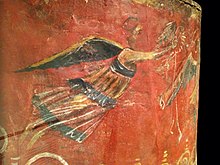Scutum from Dura Europos
The scutum from Dura Europos is the only surviving scutum from Roman times . It is now in the Yale University Art Gallery (inventory number 1933.715). The shield was found in the excavation campaign in 1932/33 on Tower 19 of Dura Europos (in present-day Syria ). The city was besieged by the Sassanids in 256 , eventually captured and largely destroyed. The place is in the desert. The dry climate enables very good conservation conditions for organic materials such as wood. Since the city housed a Roman garrison and was lost during a siege, a particularly large number of weapons were found during the excavations.
construction
The shield is 105.5 × 41 cm and is mainly made of wood. The scutum was found disintegrated into thirteen parts. It is made from strips of wood that are 30 to 80 mm wide and 1.5 to 2 mm thick. They are put together in three layers, so that the total thickness of the wood layer is 4.5 to 6 mm. In the center of the shield is a hole that was probably cut in the wood after the board was made. The shield boss that was once there is missing. The back of the shield had reinforcing strips of wood, but they have all disappeared. There appears to have been a red overlay of skin on the back. It is mentioned in the preliminary report of the excavation, but is no longer preserved today. The surface of the front had been covered with fabric and then with skin or parchment. There is a painting on it. There are several decorative ribbons around the central hole. In the upper part of the shield there is an eagle with two goddesses of victory. A male lion can be seen in the lower part.
The shield has been heavily restored several times. The main aim of these earlier restorations was to preserve the paintings, while the restorers did not care about the construction of the shield. Many technical details can only be traced today using old descriptions. The shield is now more rounded than in the original state.
Finding circumstances
The shield was found during excavations in 1932/1933 in tower 19 of the city wall . This is on the west side of the city. The events that took place during the siege could be reconstructed. The city seems to have been under constant attack by the Sassanids since the 220s . Shortly after 250 it even fell into the hands of the Sassanids, but was recaptured by the Romans in 254. During this time, the west side of the city was reinforced. The east side, on the other hand, is on a steep slope and did not need a city wall, but there seems to have been a gate to the Euphrates . In the case of the wall on the west side, adjacent houses were included in the wall and filled with clay bricks, so that a massive wall was created. This was fortunate for archeology: the structures incorporated into the wall were in excellent condition.
In 256 there was a major attack by the Sassanids. A camp larger than herself was set up west of the city. A major operation during the siege was to subvert the city wall to bring it down at one point. This action was not hidden from the Romans, and they dug their own tunnel to meet the enemies underground and to fight them. What exactly happened next is controversial in research. In any case, twenty skeletons of Roman soldiers with full equipment were found in the tunnel , but only one body of a Sassanid. In the preliminary report on the excavations, it was assumed that the tunnel simply collapsed and buried the soldiers. More recent considerations come to a different scenario. Accordingly, the Sassanids noticed that the Romans were digging a counter tunnel and waited for it to break through. When the Romans broke through the tunnel of the Sassanids, they were "received" with a fire - reinforced by naphtha . The Roman soldiers burned or suffocated. The Sassanids then continued to build the tunnel until tower 19 and the wall partially collapsed, probably only a few hours, at most a few days later. Numerous objects were buried inside the tower, some of which were burned and fell from the upper part of the tower, and they were stored here. They are mostly weapons that have been remarkably well preserved, including the scutum. The action as a whole failed, however, because the tower and the wall only partially collapsed and no breach was created in the wall.
Individual evidence
- ↑ Simon James: Dark Secrets of the Archive: Evidence for "Chemical Warfare" and Martial Convergences in the Siege-Mines of Dura Europos , in: Lisa R. Brody, Gail L. Hoffman (eds.): Dura Europos, Crossroad of Antiquity , Boston 2011, ISBN 978-1-8928-5016-4 , pp. 295-317.
- ↑ Simon James: The Excavations at Dura-Europos conducted by Yale University and the French Academy of Inscriptions and Letters 1928 to 1937, Final Report VII: The Arms and Armors and other Military Equipment. British Museum Press, London 2004, ISBN 0-7141-2248-3 , p. 38.
literature
- Michael I. Rostovtzeff , Alfred R. Bellinger , Clark Hopkins, Charles Bradford Welles (eds.): The Excavations at Dura Europos, Preliminary Report on the Fourth Season, 1932–1933. Yale University Press, New Haven 1936, pp. 456-466, panels XXV-XXVI.
- Simon James: The Excavations at Dura-Europos conducted by Yale University and the French Academy of Inscriptions and Letters 1928 to 1937, Final Report VII: The Arms and Armors and other Military Equipment. British Museum Press, London 2004, ISBN 0-7141-2248-3 , pp. 182-183 (No. 629), plate 10.


